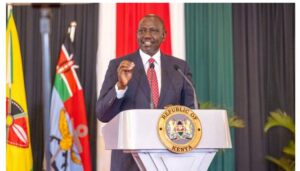New Report casts doubt on Chinese debt-trap threat to Mombasa port
Chinese debt-trap; A New Report casts more doubt on the Standard Gauge Railway (SGR) debt and the Mombasa Port.
The relationship between the Standard Gauge Railway (SGR) debt and the Mombasa Port has been called into question by a recent research from the China Africa Research Initiative (CARI).
The report titled How Africa Borrows From China: And Why Mombasa Port is Not Collateral for Kenya’s Standard Gauge Railway released on Thursday, April 14, differed with the Office of the Auditor General (OAG)’s statement that the port had been used as collateral in the repayment of the SGR loan.
The auditor general said Kenya could be made to surrender control of its port in Mombasa if it defaulted on a US$3.6 billion loan from China used to build the Mombasa-Nairobi Standard Gauge Railway (SGR).
The warning came as speculation mounted that China had deliberately indebted Sri Lanka to seize its Hambantota port.
However, the Chinese and Kenyan governments both denied that Mombasa port was collateral for the loan but offered no explanation, leaving the exact terms of the contract shrouded in secrecy.
Kenya borrowed US$3.6 billion from China’s Export-Import Bank to develop a railway between Mombasa, a coastal port city, and Nairobi, the capital. The railway was then extended to Naivasha, a town in the Central Rift Valley, using another US$1.5 billion borrowed from the same bank.
The Kenyan auditor general indicated in a leaked letter in late 2018 that the Mombasa port was the Kenya Ports Authority’s most valuable asset, and that if Kenya defaulted on the SGR loans, China Eximbank would take over the port.
If the rail’s freight operations fail to generate enough cash to pay off the loans, the earnings from the port might be used to directly repay Kenya’s debt to the bank, according to the auditor general.
According to the auditor general, the port authority was also expected to inject enough freight onto the rail to ensure its profitability and maintain the mandated minimum quantities.
Also read,
Fuel Crisis; Why Rubis CEO Jean Christian Was Deported
Fuel Prices; EPRA Issues Show Cause Letters to Oil Marketers as it Announces New Prices
Chinese debt-trap threat to Mombasa port
The new report, which was created by the Johns Hopkins University School of Advanced International Studies indicated that the port was SGR’s major customer.
The port, which is managed by Kenya Ports Authority (KPA), was to ensure that a certain level of cargo transported on SGR is maintained.
“Instead of serving as collateral or security for the loans, the profitable Mombasa Port was linked into the SGR project as its major customer.
The port’s only role was to help Kenya Port Authority (KPA), its owner, ensure that a set level of cargo would be transported between Mombasa and Kenya’s inland capital of Nairobi.
“If cargo levels dropped below that level, KPA agreed to draw on its own revenues to make up the difference. Repayment of the SGR loan will largely come from Kenya’s Railway Development Levy (RDL), a tax on all imports into the country,” read the report in part.
The report was a response to a 2018 report where the OAG indicated that Mombasa Port risked seizure if Kenya defaulted on the SGR loan repayments.
The OAG had further indicated that KPA had waived the port’s sovereign immunity to use it as security for the loan.
The CARI report also showed that the Kenyan Auditor General had misunderstood how the waiver of the sovereign immunity clause worked.
Instead, the sovereign immunity only served as a dispute resolution feature that allowed contracts to be solved in an international venue and not that the country had put its assets on the line.
Also read,
EPRA Punishes Oil Marketing Companies Over Fuel Shortage
‘Wings to fly’ to stop sponsorship to indiscipline students
Follow us






